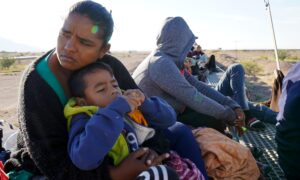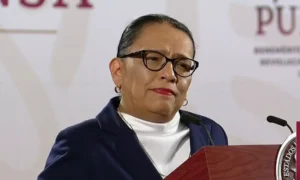Gender violence in Latin America is a reason for forced displacement, however, it does not end when a woman migrates, but rather she faces different forms of violence along the way
By Alicia Fernández / La Verdad
Miroslava saw the ocean for the first time when she arrived in Coatzacoalcos, Veracruz, while on her journey through Mexico toward the United States after settling in a house converted into a hostel near the beach. Afraid that her ex-partner would find her and fulfill his promise to harm her, the 46-year-old fled Honduras, her homeland.
To protect her 10-year-old daughter, Miroslava, whose real name we changed for safety reasons, suddenly left the country with a small amount of money.
“My daughter’s father attempted to rape her, and I reported it him [to the authorities.] He found out about this and sent someone to destroy my home and threaten me. I was told he [my ex-partner] was going to kill me, and that’s why I ran away; he’s a gang member”, she said.
Miroslava lived with her ex-partner for eight years when she became pregnant with their daughter. Nine months after her birth, her partner’s personality radically changed; he verbally abused her, consumed drugs, and left her for another woman, according to Miroslava.
Her daughter’s father returned to the their life when she turned nine years old, in what Miroslava thought was an attempt to reconnect with his daughter. She later realized his real intention was to abuse the girl, she later learned.
“One day, I came back [home] from running errands, and I saw my daughter in the bedroom, fighting to get him [her father] off her after he took off her clothes. I pushed him to the ground, took my daughter with me, and locked us in a bedroom. There, the neighbors heard the noise and called the police. When they arrived, he had already left the house. They couldn’t get him,”, she said.
She decided to leave her country and has since spent six months on the move with her daughter, living from the charity and help of people they meet along the way. Despite the uncertainty, she continues her journey through Mexico to get her daughter far away from danger.
“We are in fear and have to take risks. Violence and all kinds of dangers are abundant along the way. I just say, ‘I will continue moving forward to protect my daughter.’ I would give my life for my daughter,” she said.
***
Women leave their country to escape violence, but this follows them along the way. Through their journey and temporary stay in Mexico, migrant women stay in unsafe public areas where they experience gender violence, extortion, and abductions.
Their reproductive health rights are violated by having limited or non-existent access to medical services, such as abortion and prenatal care, and education and information on reproductive health. These specialized services for mothers can promote access to their financial independence, such as safe spaces designated for underage single mothers and early childhood daycare.
***
Along the journey, Miroslava met Yeimi, a woman who also fled her home country of Honduras to escape her abusive ex-partner.
“I asked for his help after finding out I was pregnant. He told me the best option for me was to have an abortion because he was not the father. He denied me from keeping the baby,”, said Yeimi.
Her sisters looked for a job to help her get out of her situation, but living with constant screaming and verbal abuse from her ex-partner, Yeimi decided to flee.
Now eight months pregnant, she travels through Mexico, going to the U.S. with her father.
Miroslava’s and Yeimi’s stories are not unique, as 60% of women who seek asylum in Mexico from Honduras, Guatemala, and El Salvador fled their countries due to violence, according to the United Nations High Commissioner for Refugees (UNHCR).
Apart from fleeing gender violence, women attempt to free themselves from institutional and governmental violence. “Many women travel alone. They flee Venezuela for its violence by government agencies, from Honduras for their political persecution, or like the case of the women from Haiti, generalized violence in their countries,” said Ángeles Roque of Alternativas Pacificas [Peaceful Alternatives,] a non-profit organization that provides care to migrant women in Matamoros, Tamaulipas.
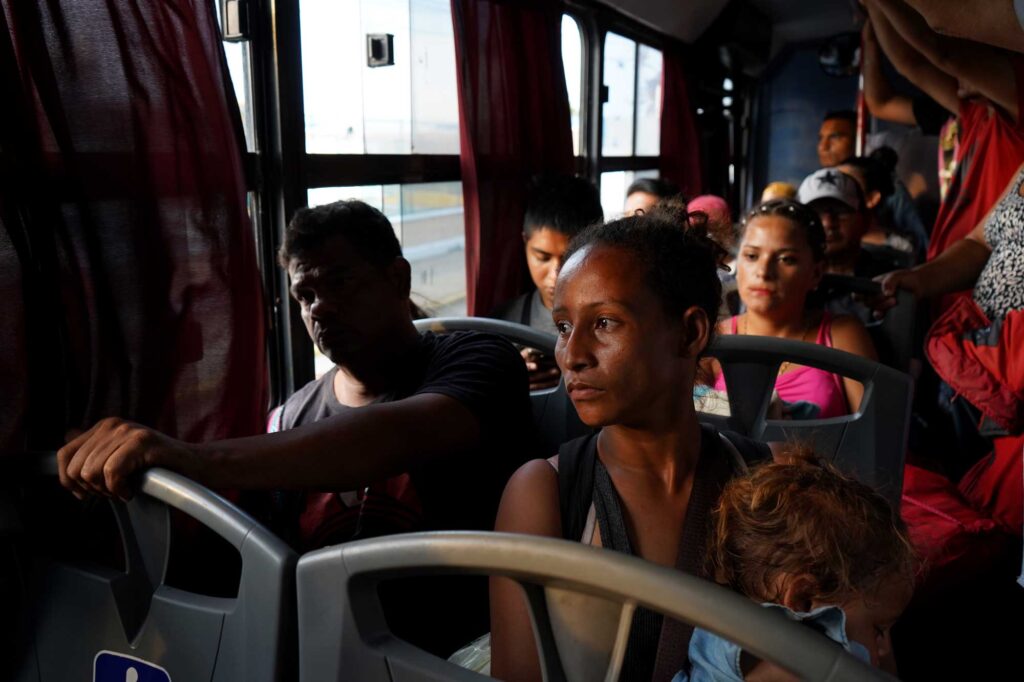
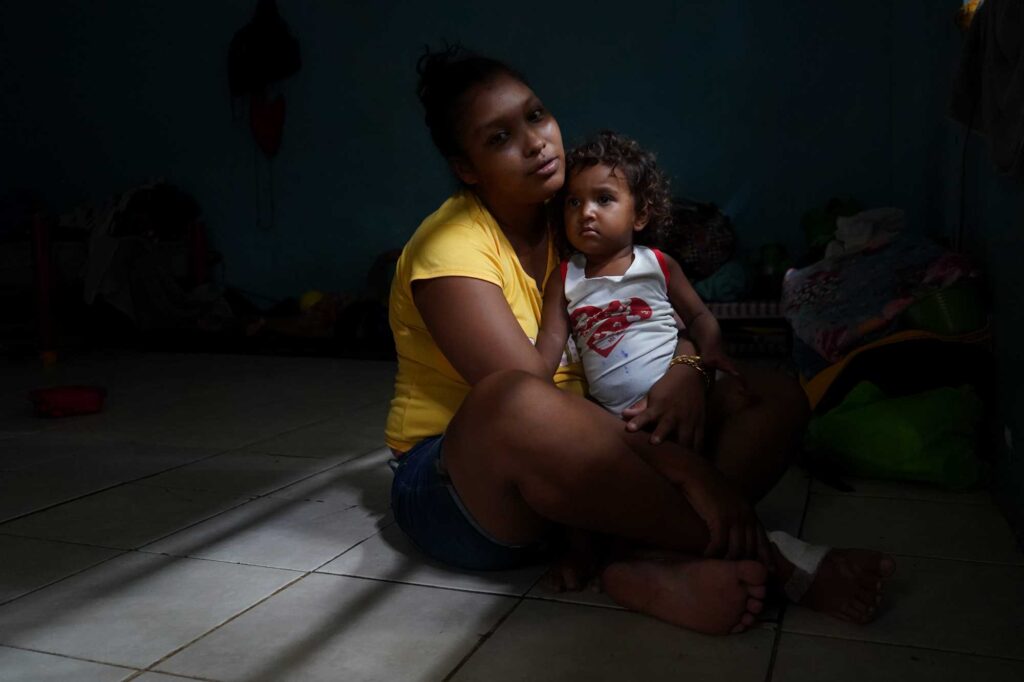
A woman in a migrant shelter sits next to her son while recovering from a broken ankle in Tapachula, Chiapas.
A migrant woman rides public transportation to a shelter in Coatzacoalcos, Veracruz, with her son

While they flee violence at home, women encounter this same issue on the road to the northern Mexican border. “Many Women who are the heads of their homes, who own a business, and who have their lives together are attacked by different criminal groups in their countries. And fleeing from that situation, they find it again in their migration journey. It feels like a little more of the same problem,” said Roque.
In Mexico, migrant women suffer persecution beyond international borders. Discrimination and abuse by local police, Mexican National Guard and Mexican National Institute of Migration agents, and the general population, according to a 2023 report on migrating women and girls by the Mexican Institute for Migrating Women (Instituto para las Mujeres en la Migración, IMUMI.)
In 2022, 52,586 migrant women in Mexico received visitor’s cards for humanitarian reasons. More than one-fifth (21%) of these permits were issued to women who are victims or witnesses of a crime. The top countries of origin of these applicants were Honduras, Nicaragua, Cuba, Haiti, and Venezuela, according to IMUMI.
From January to April 2023, Mexico issued 20,082 of these documents, and one of the most prevalent reasons (10% of all cases) for these requests is being a victim or witness of a crime and the top countries of origin for these are Guatemala, El Salvador, Honduras, Haiti, and Venezuela.
Regarding asylum requests based on gender, several civil society organizations that work with migrant women have recorded that many victims of gender violence seeking asylum do not receive recognition from authorities.
These organizations had published about the limitations on women’s asylum processes: “The lack of psychological first aid training of authorities, few private and confidential spaces to communicate details of violence, little access to eligibility interviews carried out by people of the same sex, shallow investigations for documenting violence, among other issues, negatively influence the resolution,”
Long waits for a response from immigration authorities have a “decisive” impact on the applications of female victims, according to the Mexican Refugee Aid Commission (Comisión Mexicana de Ayuda a Refugiados COMAR.) Although the maximum processing period is 30 days, they document cases that last more than six months.

In addition to limited access to medical and psychological care, in addition to being victims of all possible violence deteriorates the health and finances of migrating women.
Many women take refuge in provisional aid centers and migratory stations without adequate sanitation conditions while waiting for a legal response. Shortages in essential products for menstruation in migrant shelters in central and south Mexico forces women to turn to using fabric sanitary pads, according to the Mexican National Mechanism for the Prevention of Torture (Mecanismo Nacional de Prevención de la Tortura MNPT.)
In northern Mexico, poor public safety and health services in makeshift camps are a source of infections and diseases for women.
Fatima, a 39-year-old Nicaraguan stuck in Matamoros, Tamaulipas, set up a hammock in a temporary campsite next to the Rio Grande near the border crossing of Brownsville and Matamoros, where thousands of migrants live. She stopped having her period after falling sick at the camp multiple times.
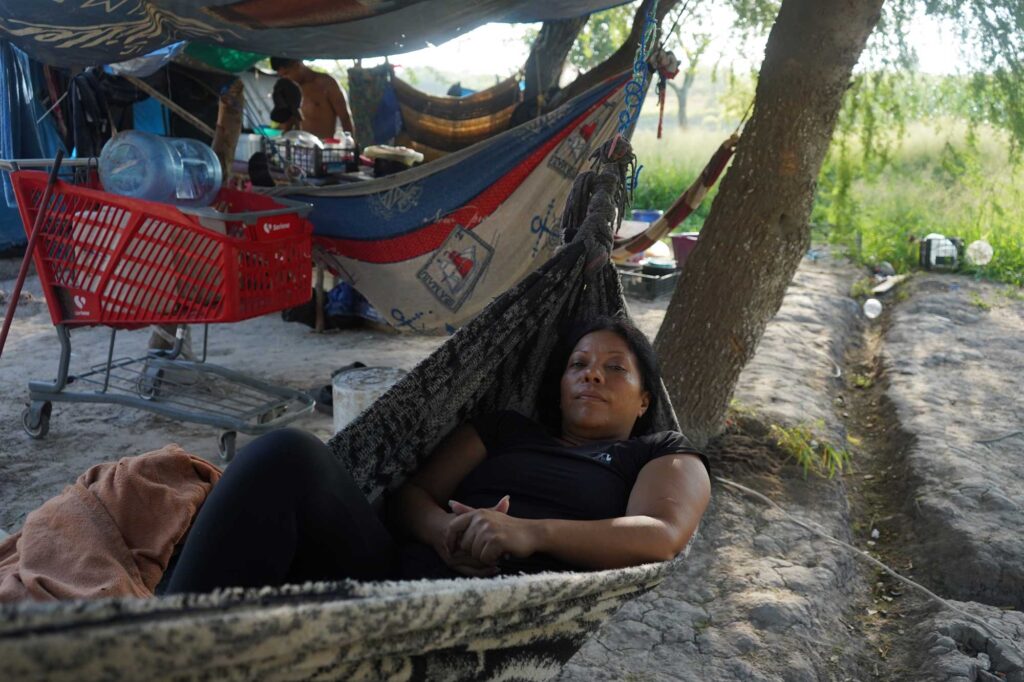
For more than ten days, she has been recovering from a severe stomach infection that made her drop 17 pounds. She seeks an immigration appointment to request asylum in the U.S. daily.
“We haven’t gotten an appointment yet, and the stress of the appointment disrupts your period. You overthink. One has no peace here, one feels practically imprisoned because one has no social life, you don’t have anything”.
***
This report is part of the series The invisible pain of migrant women, produced with the support of the International Women’s Media Foundation (IWMF) as part of its Reproductive Rights, Health and Justice in the Americas initiative.



